
Lead Generation for Lawyers: A 2024 Guide
Aside from dealing with difficult clients and long hours, lawyers say that the most challenging aspect of their job is generating new clients (source).
The lack of new clients is not due to a lack of trying.
Law firms spend millions of dollars on marketing and advertising campaigns to try and generate new business.
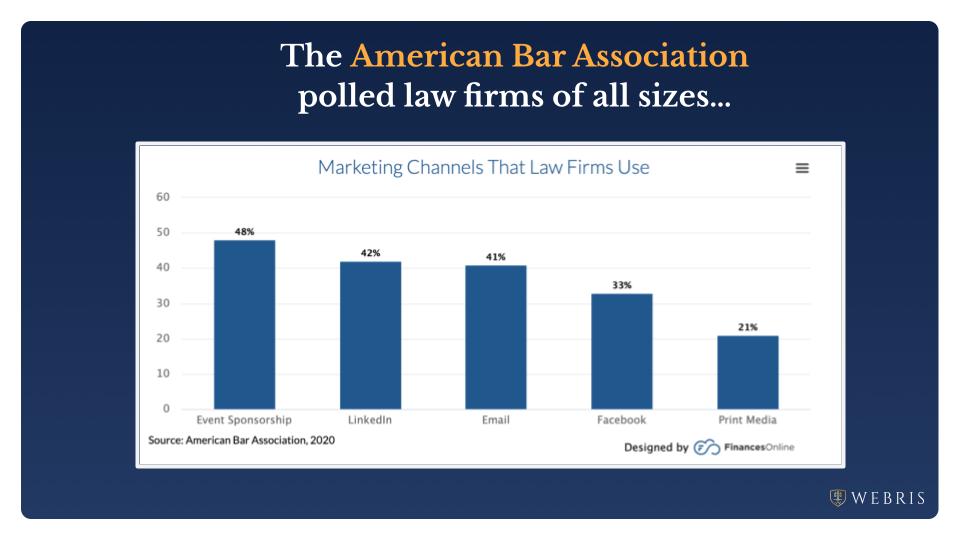
The reason why so many law firms struggle to get new clients is because so many are deploying the wrong strategies.
This graphic above is proof. None of the strategies listed up there are effective.
This post will outline the best way to invest your law firm’s marketing budgets to drive the most new cases.
Check out our videos for deeper insights, or tune in to our Podcast for legal marketing insights on the go.
Where most law firms think leads come from
If there’s anyone that understands the power of marketing and advertising, it’s lawyers.
Without it, no one will know your law firm exists, especially if you’re just starting out. Relying solely on word-of-mouth would require folks to know others who went through a similar ordeal — what are the odds of that?
With all the resources today, it’s easy for lawyers to attract a ton of traffic. The problem is converting them into qualified cases (aka NO tire kickers).
The problem isn’t the marketing, it’s the strategy. Most lawyers have issues with two things:
- Using channels that require a ton of effort that you simply don’t have time for
- Wasting money on expensive methods that should be redirected to efforts with higher result
Let’s investigate this further.
Expensive BBBs (bus, bench, and billboard ads)
It seems the legal industry has a monopoly on bench ads — everywhere you look in metro areas, you’ll find a lawyer on the back of a bench or cruising by on the side of a bus.
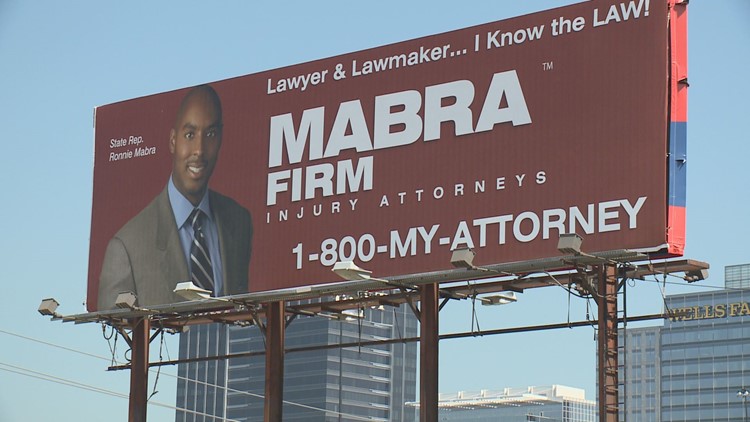
Makes sense to use these mediums because these items are seen by thousands of people each day.
However, there’s 2 reasons why you should NOT:
- They’re expensive
- They don’t work
Sure, it may help your law firm’s “brand” to be visible to so many, but very few (if any) of those people will ever seek your services.
Also, just being visible doesn’t mean people are actually seeing your ads.
Studies show that very people people pay attention to these types of ads, because they are almost always buried in their phones when present.
Social media (paid and organic)
Social media is the virtual version of cities that might generate visibility for law firms. However, social media platforms don’t make this easy.
You see, social networks like Facebook, Instagram, and LinkedIn use algorithms that prioritize certain types of posts published by certain types of profiles.
If you don’t understand the algorithm and how to rank on it, then your organic social media posts will go unseen.
So unless you have a large following — which can take months or even years to achieve — you’re stuck with low reach and engagement.
Most lawyers lack time to dilly and dally on social media to grow an engaged audience. So unless you’re a natural content creator and have an audience, then it’s not ideal to start with.
But what about paying for visibility?
That’s a valid option — you can pay social networks to boost an organic post (aka sponsored posts) based on your targeting options. And you can use social media ads.

There’s nothing wrong with paid social, but it should be something you invest in after dominating Google’s search engine results pages (SERPs). After all, that’s where people go to look for legal help…not social media.
Where top law firm’s leads actually come from
TL;DR…Search Engines (mainly Google).
Think about it: when someone needs help with a legal problem, what’s the first thing they do?
They Google it.
For example, “what to do when getting sued by a landlord” or “DUI laws in Miami FL”.
Or even better, if they’re ready to speak to an attorney right away, they’ll search for “DUI attorney near me”.
This is where most high-quality leads come from because it’s people who are actively looking for help with a case today.
It’s likely you already know this. It’s also likely that you’ve already invested into some form of search engine marketing (SEO, PPC Ads) and saw little to no results.
This is where most law firms find themselves – aware that they need search engine traffic, but unable to get the results from SEO or PPC campaigns.
Let’s break down why so many law firms struggle with search marketing by taking a look at Google when searching for an “attorney near me”:
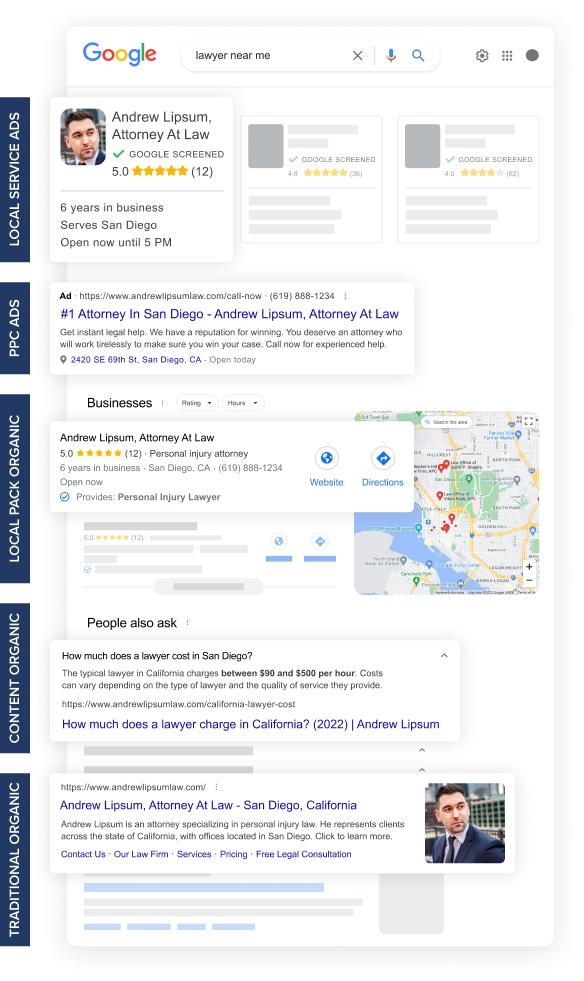
There’s a lot happening here…
- Local service ads
- Pay Per Clicks ads
- Local “Maps Pack” organic listings
- “People also ask” organic content listings
- Traditional organic results
All of these sections attract eyeballs and clicks – if you’re not attacking all of them, your campaigns will fail.
The key to generating more leads from search engines in 2024 is to be hyper present in all elements of search…aka a “Blended Search” approach.
“Blended Search”: The key to more cases (and fewer tire kickers)
Dominating the search results sounds like a master plan. But how does it actually work? We use a proven strategy to help law firms appear in all areas of the SERPs.
But enough talk — here’s how we do it.
Step 1: Paid search
Starting with paid search is the best thing you can do for your law firm. It offers fast results — some get calls within hours.
But this isn’t the only reason — PPC ads open the door to finding what we call “winning keywords.”

These are the search terms that drive the highest quality leads at the lowest cost.
Since PPC ads generate engagement fast and wide, we get a ton of insights that help us quickly identify which keywords to target or negate (so your ads don’t appear in searches of lower quality leads).
The PPC process we use and recommend includes:
- Tracking and reporting: Building reports so we can measure the costs per call, form submission, and lead (to find the high-value keywords)
- Keyword research: Analyzing your market, offers, and prospective clients to determine the best keywords to test
- Landing page design: Creating a custom and optimized landing page where all ad traffic will go (and a major key to converting visitors into leads)
- Ad copywriting: Designing an ad with only two sentences of text and no visuals (where copywriting expertise is critical — we work with the best)
- Setting up an ad campaign: Building your Google Ads campaign to run and monitor ads (this is where you’ll monitor what’s working and what’s not)
- A/B testing: Experimenting with elements to see what converts best (e.g., different headlines, calls to action (CTAs), and offers)
- Scaling winners: Seeing what works to zone in on those keywords and maximize results
Read more: Complete guide to Pay Per Click Ad campaigns for law firms
Step 2: Local service ads
This is another form of paid search we use to attract the eyeballs of your best prospects. They include a photo of you and important details about your law firm:
- Address
- Phone number
- Hours of operation
- Service area
- Star rating and number of reviews

All the factors people care about when hiring an attorney. We help your law firm appear in these results by:
- Creating a custom landing page optimized with the same winning keywords as the ad
- Optimizing to improve outcomes
- Bidding on winning keywords
- Monitoring results
This process helps you get quality clicks that are most likely to convert into big bucks for your firm.
Step 3: Local SEO
Now, to dominate local SEO for lawyers, you must appear in the local 3-pack next to the visually appealing map. And to do this, you must build your Google My Business Profile (GBP).
Unlike the first two steps, this isn’t a paid strategy.
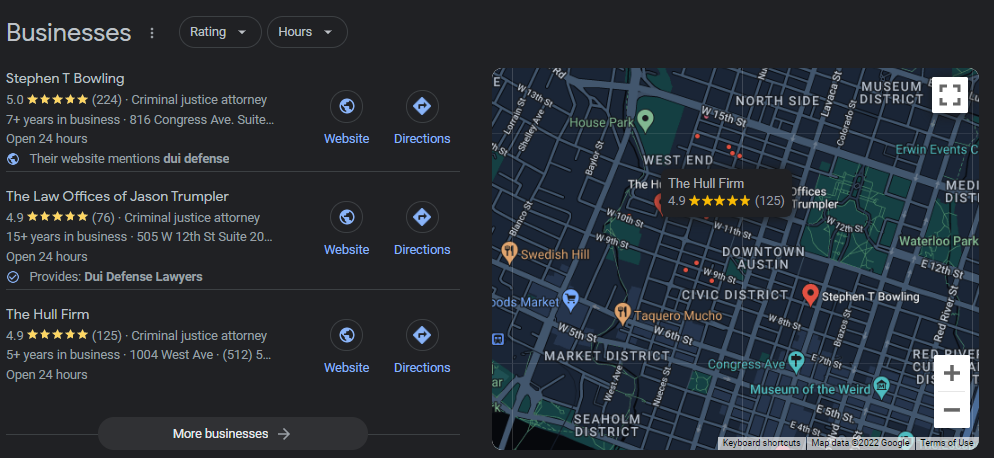
The goal to appear in the top three results is to fill out your profile completely and optimize it with your winning keywords. Here’s what to do:
- Include critical business details (e.g., business name, address, hours of operation, URL, phone number, and business description using target keywords)Select your business categories (e.g., family law, DUI, etc.)
- Add a cover photo (e.g., law firm’s interior, exterior, or even yourself and partners)
- Get reviews and ratings from happy clients to boost your credibility (and ranking)
- Build local citations across platforms like Avvo (FindLaw, Justia, etc)
Your GBP isn’t something you do once and forget about. You must consistently update it, such as when your number or address changes or you add more locations.
It’s also ideal to have a review solicitation strategy to continue getting reviews from satisfied clients.
For example, sending a template email with a link to a survey to learn about their experience. And then asking them to publish their review to Google (after seeing it’s positive).
And you need a landing page that’s optimized with the same keywords as your local listing.
Read more: Complete guide to Local SEO for law firms
Step 4: Traditional SEO
Traditional SEO builds the foundation of your search engine marketing success.
We do this simultaneously with the other steps in this process to maximize outcomes in the quickest time possible.
Some the things we focus on at this stage include:
- Auditing your site for technical SEO (can Google’s bot crawl it and is it easy for visitors to navigate?)
- Building a customized landing page using your winning keywords
- Optimizing or creating key pages (e.g., service pages, location page, home page)
- Targeting snippets, PAA, and #1 position in SERPs
Blog posts, guides, and videos can improve your odds of getting ranked on the first page of Google.
For example, in each blog post, we recommend having an FAQ section that targets People Also Ask questions box.
Read more: Complete guide to SEO for law firms
Step 5: Content marketing
Content marketing is another “free” marketing strategy that can land you spots in the PAA box, snippets, and #1 spot in the search results.
To achieve these positions, you can use various forms of content, including blog posts, guides, and videos. The idea is to use your winning keywords to optimize your content.
These keywords should appear in your title, one or two subheadings, and sprinkled throughout the post.
Here’s an example that targets the term “slip and fall lawsuit”:
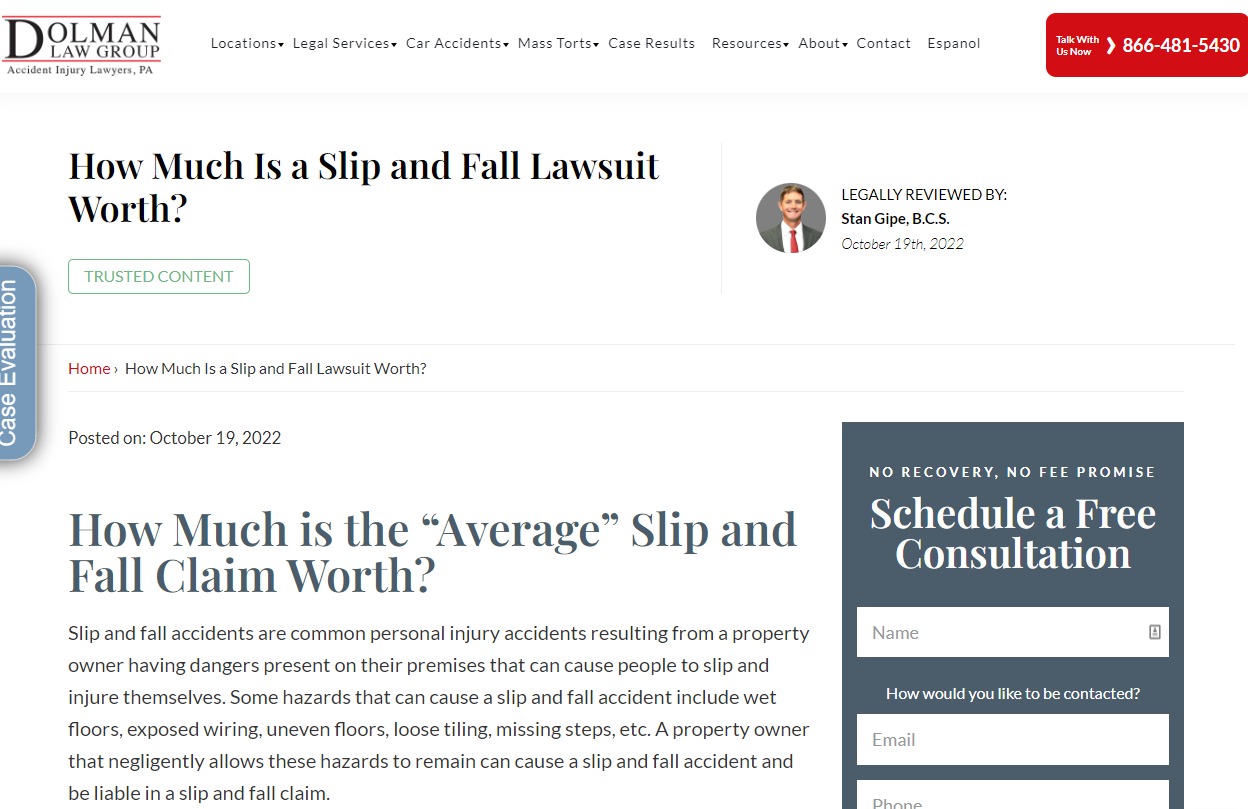
You see the title at the top uses an exact match keyword, then the H1 at the bottom uses a related keyword “slip and fall claim.” Using a mix of keywords helps your content rank for multiple search terms (not everyone searches the same).
Plus, it tells Google your content is super relevant to the target audience.
This covers ranking high on organic search — what about getting the snippet?
Capturing more snippets (and eyes)
There are tactics you must use to capture to gain a snippet.
For one, you must structure your blog post or landing page a certain way.
For instance, if the question is “What is the common sentence for DUI offenses?” then you’ll create an H2 or H3 sub-heading that asks this question. In the paragraph beneath, it should answer this question clearly.
For example, the first sentence can start like this: “The most common sentencing for DUI offenses is between x and y, but depends on several factors, such as…”
This tells Google you’re answering the question, which will help their searchers. And that’s all Google cares about — making a great search experience for people.
Build quality content and backlinks
Content marketing is another area that requires consistency to reign supreme.
In other words, you need to publish quality content regularly to show Google your site is relevant and fresh.
When building client content machines, we select the topics and use legal professionals who understand your industry to write your blog posts. This exudes authority and trust, which is vital for turning visitors into leads.
Plus, it’s beneficial for gaining backlinks from high-authority sites, which boosts your domain authority, Google ranking, and overall traffic.
Results from using “Blended Search” marketing
“Blended Search” marketing is an in-depth approach to dominating the first page of Google. But how well does it work for converting high-quality traffic into leads…and leads into sales?
Cueto Law Group, a legal client of ours, saw its monthly visitors grow from 40 to nearly 7K within one year. That’s a 12,947% increase.
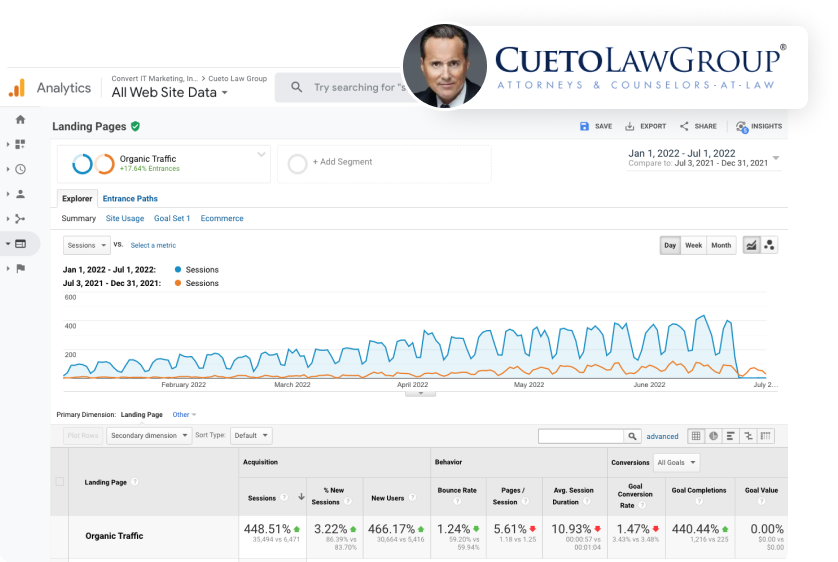
And another one of our clients, Brotman Law, saw its monthly visitors grow by 248%, from 8,609 to over 30K.
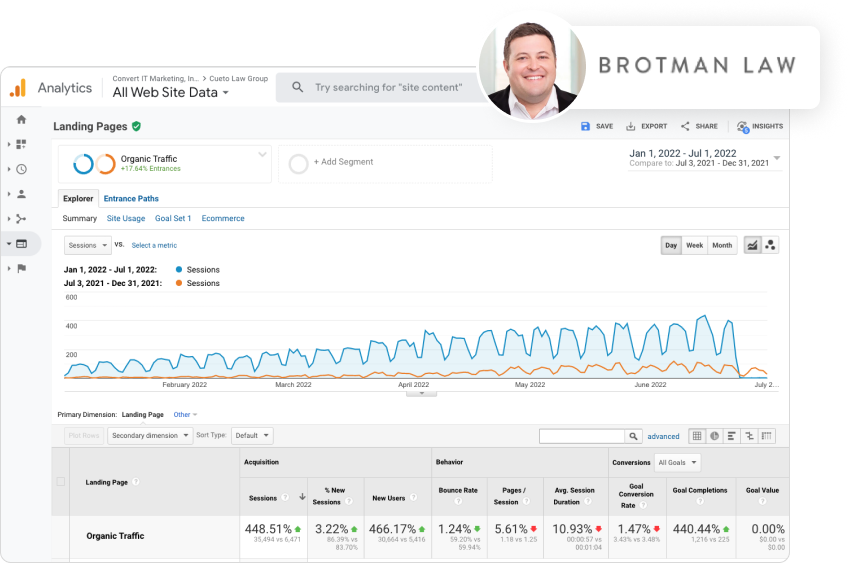
Every time we run a sprint (three in all), we see massive gains:
But how will you know it’ll work for you?
Well, our engineering team built a tool that predicts the results of lawyer SEO campaigns based on your site’s data, past performance, and competitive market. So before we begin working on PPC for lawyers, they know exactly what outcomes to expect.
Like law, marketing is best left to the experts
Cases to read. Motions to file. Consults to give. There’s a lot on your plate as a lawyer — why add another side?
Marketing isn’t something you can jump into and learn overnight. It requires many years of experience learning the craft and building proven processes.
So avoid the learning curve and continue doing what you do best: winning cases. Allow us to manage lead generation so you can avoid tire kickers and get more high-quality leads calling your office.
Your prospects are waiting, but they won’t forever — contact our growth team to get started dominating search engines today.
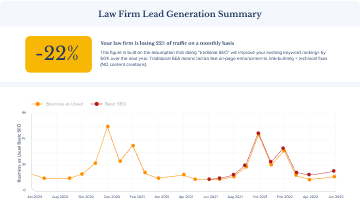
Your Website Is Losing Money!
Find out how many leads your website SHOULD be getting through our Traffic Projection Analysis.
FIND OUT MOREIs Your Website Costing You Clients?
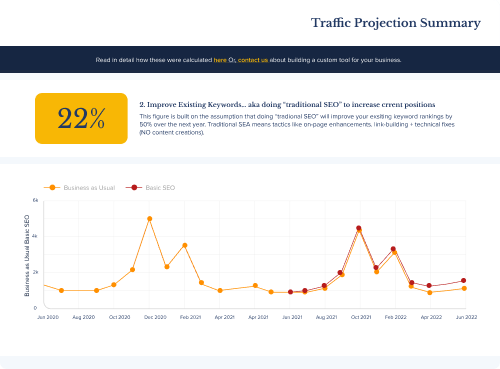
Is Your Website Costing You Clients?
Find out how many new cases your website SHOULD be getting through our Traffic Projection Analysis.
A data driven analysis that accurately forecasts how much traffic (and cases) your website should be getting from Google each month.
BOOK MY ANALYSIS